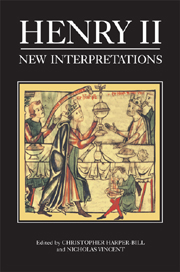Book contents
- Frontmatter
- Contents
- List of Illustrations
- Editor's Preface
- List of Abbreviations
- Introduction: Henry II and the Historians
- The Accession of Henry II
- Henry II and Louis VII
- Doing Homage to the King of France
- Henry, Duke of the Normans (1149/50–1189)
- Henry II and England's Insular Neighbours
- Henry II, the English Church and the Papacy, 1154–76
- On the Instruction of a Prince: The Upbringing of Henry, the Young King
- Henry II and the Creation of the English Common Law
- Finance and the Economy in the Reign of Henry II
- Henry II and the English Coinage
- The Court of Henry II
- Literary Culture at the Court of Henry II
- Henry II and Arthurian Legend
- Index
Henry II and Louis VII
Published online by Cambridge University Press: 12 September 2012
- Frontmatter
- Contents
- List of Illustrations
- Editor's Preface
- List of Abbreviations
- Introduction: Henry II and the Historians
- The Accession of Henry II
- Henry II and Louis VII
- Doing Homage to the King of France
- Henry, Duke of the Normans (1149/50–1189)
- Henry II and England's Insular Neighbours
- Henry II, the English Church and the Papacy, 1154–76
- On the Instruction of a Prince: The Upbringing of Henry, the Young King
- Henry II and the Creation of the English Common Law
- Finance and the Economy in the Reign of Henry II
- Henry II and the English Coinage
- The Court of Henry II
- Literary Culture at the Court of Henry II
- Henry II and Arthurian Legend
- Index
Summary
Perhaps historians of the present generation are unusually well qualified to understand the atmosphere which prevailed in western Europe during the period 1151 to 1189, because, although there are obvious differences of scale, the analogies with the mature Cold War era are quite strong. In the first place, there was a long period of tension between two rival powers, occasionally exploding into conflict on one frontier or another. Then there were endless negotiations to try to defuse the tensions, initiated sometimes by one of the parties to the conflict, sometimes by apprehensive onlookers attempting to divert the protagonists' attention to other international challenges. Thirdly, there was a host of more localised conflicts that got caught up in the maelstrom, as lesser powers strove to involve the principals in their strategies by invoking the mantra that ‘my enemy's enemy is my friend’. The final analogy, the unexpected and almost complete crumbling of one of the parties, is not our concern here. But inevitably it remains in our minds.
The differences between the two situations are as sharp as the similarities. Whereas the Soviets and the Americans emerged from the Second World War as new rivals — two superpowers, ideologically opposed, together dominating the world yet capable of destroying each other — the situation in 1151 when Louis VII recognised the young Henry as duke of Normandy was entirely different and far more complicated. In the first place, as heir to the counties of Anjou and Maine, Henry belonged to a line that had for a long time demonstrated rather ostentatiously its loyalty to the Capetian kings.
- Type
- Chapter
- Information
- Henry IINew Interpretations, pp. 47 - 62Publisher: Boydell & BrewerPrint publication year: 2007



